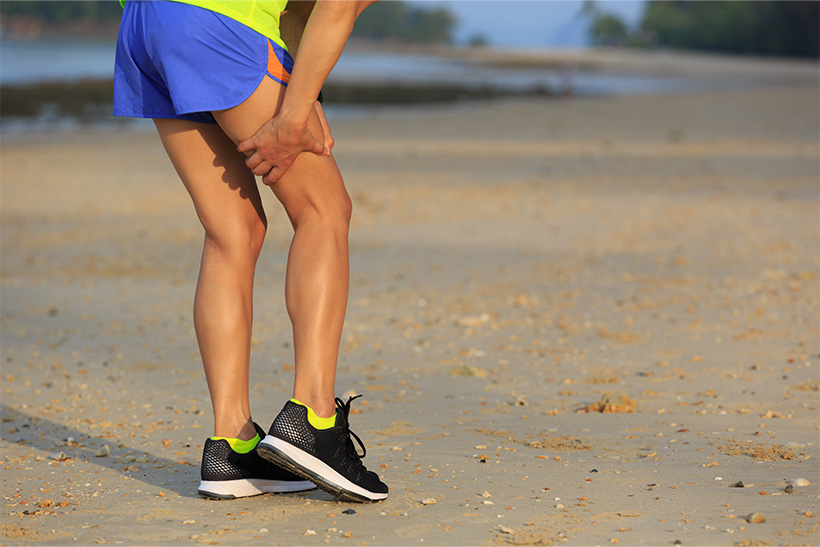Sports Injuries — Causes, Types & Treatments


Playing sports is a good way of staying active and maintaining one's physical and mental wellness. However, the risk of injuries during sports activities is unavoidable.
Sports injuries are common in any athletic activity and can occur to both professional and amateur athletes. These injuries usually happen when our body or a specific part of our body is subjected to a sudden impact or force.
The risk of injury among individuals who engage in high-performance sports tends to be higher than the average. Children and the elderly are also at a higher risk of getting injured because their bodies tend to be more delicate. People who are out of shape or rarely exercise fall into this group too. However, sports-related injuries should not discourage you from participating in these activities. We will just have to be aware and take note.
When it comes to common injuries in sports, you may tend to ask yourself these questions: What are the different types of sports injuries, and how are they different from one another? How can we minimise the risk?
Read on to find out more about sports injuries, their causes, when to seek medical attention, and how you can avoid them.
What causes sports injury?
There are several causes of sports injuries; each differs in terms of the level of physical trauma sustained or the pain intensity. The two leading causes of sports injuries are due to insufficient warm-ups and accidents.
Lack of Sufficient Warm-up
Warming your body up is necessary before performing vigorous exercise or engaging in sports, as it helps to condition your joints and muscles. If you were to skip warm-up exercises, the likelihood of you getting of a joint or muscle injury is higher, because your body is unprepared to handle the stress.
Make sure to start your exercise routines with warm-ups to avoid injuries. A 20-minute warm-up is sufficient to prepare your body for any physical activity, including high-performance sports like rugby, volleyball, or soccer.
Accidents
Accidents are one of the most common causes of sports injuries and they can happen to anyone. The risk of sports-related accidents is significantly higher for those who engage in contact and collision sports, such as MMA, hockey, soccer, and basketball, to name a few.
Athletes who get into accidents could suffer from any of the following common injuries:
-
Sprains
-
Strains
-
Fractures
-
Concussion
-
Bruises
-
Bleeding
-
Abrasion
-
Cuts
-
Shin Splints
Since injuries like the ones mentioned above can happen frequently, especially if you're an athlete, it's ideal to have adequate insurance coverage, such as a personal accident insurance plan like ProtectionPlus to cover any unwanted medical expenses.
Other Causes
Given the number of factors to be considered when engaging in or playing sports, sports injury is not just limited to accidents or insufficient warm-up. There are many other reasons why injuries are sustained:
-
Lack of or improper use of equipment
-
Improper rehabilitation practices
-
Excessive or insufficient training
-
Poor nutrition
-
Fatigue
-
Poor conditioning
-
Playing on uneven or hard surfaces
Types of Sports Injuries
Experts in sports medicine classify sports injuries into three categories: traumatic, overuse, and chronic. These injuries differ in terms of mildness, severity, and the muscle tissues involved. The most common sports injuries are as follows:
-
Sprains
-
Strains
-
Fractures
-
Concussion
Sprains
Sprains are tears in the ligaments. Ligaments are tissues that link the different joints and bones in the body that help to control movements in your joints. When ligaments are subjected to intense pressure, they flex beyond their capacity, resulting in tears. An ankle sprain is one such example.
Even professional athletes can get confused between a strain and a sprain. To determine if it's a sprain, watch out for the following symptoms:
-
Bruising around the affected area
-
Pain and swelling
-
Inability to flex affected joint
-
difficulty using the joint's full range of motion
Strains
A strain is a tear in a particular type of muscle tissue known as a tendon. Tendons are thick and highly flexible tissues that help us move our arms or legs. Strains are common in performance sports, such as mixed martial arts, weightlifting, and gymnastics. Such injury often occurs if a tendon is overexerted as a result of extreme pressure.
Some athletes mistake a strain for a sprain because these two sports injuries tend to appear the same way. However, you can tell if it's a strain through these signs:
-
Pain and swelling around the affected area
-
Muscle spasms
-
Restricted range of motion or joint flexibility
Types of Strains
-
Tennis elbow — Also known as lateral epicondylitis, tennis elbow is usually caused by an overused tendon in the wrist and forearm.
-
Lumbar strain — This pain occurs in the lower back and is usually caused by the sudden twisting or sudden pressure on the upper body. Golfers, wrestlers, judokas, and weightlifters tend to face a high risk of lumbar strain.
-
Groin strain — This type of strain occurs when the muscle in the inner thigh gets hyper-extended or torn. A groin strain is typical among runners and other sports that involve jumping, like basketball and tennis.
-
Hamstring strain — Hamstring strains occur because of actions like halting while sprinting. People who play sports like rugby and football tend to face a high risk of this injury.
-
Baseball elbow — Also known as golfer's elbow or suitcase elbow, medial epicondylitis or baseball elbow is a pain from the wrist up to the inside of the elbow. This sports injury occurs when the tendon responsible for pulling the palm toward the wrist is overused.
-
Runner's knee — Athletes with this type of injury experience pain around the kneecap. You may also experience clicking or grinding sensations while running, walking, or bending your knee.
Fractures
Fractures are some of the worst sports injuries that can happen to both professional and amateur athletes alike. Also known as broken bones, bone fractures are common in high-performance, full-contact sports, like kickboxing, hockey, and football. Forearm, orbital, and shinbone fractures are the most frequent injuries in these types of sports.
Fractures occur because of repetitive use or overuse of a particular body part, which results in stress fractures. The likelihood of soft tissue injuries may also be present. Medical experts classify a bone fracture into 5 categories, and these are:
-
Stable fractures — The bone fracture is clean, and none of the broken pieces has deviated from your alignment.
-
Transverse fractures — The fracture is horizontal to the bone shaft. The fractured pieces may or may not be lined up properly.
-
Open/compound fractures — An open wound is present in the injured area because of the fracture. Sometimes, one part of the broken bone may stick out of the open wound.
-
Comminuted fractures — Fractures with at least two or more bone fragments. These injuries often occur in sports with a high collision rate, like football.
-
Oblique fractures — The break in the bone is diagonal across the bone shaft. This sports injury usually occurs in the long bones of the body, namely: the fibula, femur, and humerus. Soft tissue damage may also be present because the breakage area is at an angle.
Concussion
Concussions are head injuries commonly referred to as traumatic brain injuries. Head blows are the primary cause of concussions in sports. An individual who suffers from a concussion may suffer from headaches, disorientation, and loss of balance and coordination.
Other Types of Sports Injuries
The other common sports injuries that also occur frequently in high-intensity activities are:
-
Bruises — Bruising is a soft tissue injury commonly referred to as a muscle contusion. This injury happens when the muscles sustain haemorrhaging, which results in internal bleeding. As blood pools under the skin, discolouration occurs. Bruising comes in second as one of the most common sports injuries, next to sprains.
-
Bleeding — Nosebleed is probably one of the typical examples of bleeding in sports. In contact sports like basketball or hockey, nosebleed occurrences are a common sight. A direct blow to your nose may instantly result in a nosebleed.
-
Abrasions — An abrasion usually occurs when you scrape your knee, palm, or elbow against a hard rough surface. This injury is typical in sprinting and marathon running.
-
Cuts — Cuts are often associated with abrasions, even though both sports injuries differ. While sharp objects are likely to cut an athlete, high-impact blows can also produce this type of injury among athletes, such as in boxing, MMA, and other combat sports.
-
Shin Splints — This sports injury happens to athletes who do not allow overworked muscles, tendons, and ligaments time to heal. A shin splint often occurs in the lower leg or the shin bone, just as its name suggests. Shin splints may progress into stress fractures and may worsen if the affected shin remains neglected.
Although there are many types of sports injuries that might occur, don't be alarmed. Participating in sport activities keep you active and having an insurance plan like the Personal Accident (PA) plan, will allow you to be assured. The PA plan is also a vital complement to your health insurance policy.
With MSIG's PA plan, MSIG ProtectionPlus, you will be protected from income loss due to accidental injuries and high hospitalisation costs. It can help to lighten your load as:
-
You will receive daily hospitalisation allowance amounting to $200 for up to 50 days.
-
If you are unable to work due to temporary total disablement, you and your family will be supported with a monthly income of $2,400 for up to 2 years in a row.
-
You will benefit from a total disability payout of up to $375,000 in the event of an accident that caused permanent and total disablement.
-
It provides coverage for third-degree burns caused by any injury.
-
The plan also offers value-added covers for motorcycle riders, injuries acquired from reservist training and leisure sports like snorkelling and wakeboarding.
-
For a consultation with a Traditional Chinese Medicine (TCM), ProtectionPlus pays for a sub-limit for treatment expenses of up to $75 per consultation per day. Receipts from a licensed or registered Chinese Physician/Chiropractor will need to be provided.
MSIG ProtectionPlus has three types of PA plans: Silver Plan, Gold Plan, and Platinum Plan to suit everyone's needs.
Treatments
Most sports injuries can be treated using two or more methods to ensure a quick and efficient recovery. Since sports-related injuries vary in pain and severity, you will be better off with proper medical attention as soon as possible. Here are the four valuable methods used in treating sports injuries. These are:
-
Rest
-
Ice
-
Compress
-
Elevate
The RICE method is ideal for mild sports injuries like sprain or bruising. This regimen should be applied immediately and continuously within the next 24 to 36 hours upon sustaining a sports injury.
Rest
Resting helps to minimise further injury so the affected area can recover fully. The reduced constant muscle movement allows the strained tendons or sprained ligaments to heal up. Giving your sprained ankle or painful tennis elbow some time to rest and heal is the best you can do to get optimal recovery.

Ice
Ice is an effective first-aid treatment for mild sports injuries like sprains or bruises. You can use a pack of crushed ice or ice-cold bottled water. Apply it directly to the injured part of the body to relieve the pain. Ice helps to reduce the blood flow in the affected area, which minimises swelling.
Compress
Applying a bandage around the injury is effective in preventing fluid buildup. Do not wrap the binding too tightly. Otherwise, this will restrict the blood flow, causing a tingling or numbing sensation. The swathe will also serve as a reminder to keep still and not move the affected area to avoid any complications to your sprained ankle.
Elevate
Elevating the injured area of your body above the level of your heart reduces blood flow. This method is beneficial for minimising swelling while increasing the chances of a fast recovery. You will also achieve the same effect if you place your injured wrist at the same level or close to your heart.
Other Methods of Treatment
There are other ways to treat sports injuries besides the RICE method. These are massage therapy and heat application.
-
Massage Therapy — Helps ease muscle strain or stiffness and improves better movement and faster muscle recovery. Do not massage the affected area if the pain intensifies due to massage.
-
Heat Application — While RICE uses ice to reduce the swelling, a warm compress has a different purpose when applied to the injured spot. A warm compress on sports injuries will dilate the blood vessels and improve the blood flow. Strained muscles or tendons will also benefit from this technique because the heat minimises the soreness and eliminates any remaining lactic acid buildup due to excessive muscle activity.
Prevention
There are ways to prevent sports injuries, and both professional and amateur athletes can benefit from them, no matter what kinds of athletic activities they are engaged in. These approaches are the most fundamental in injury prevention, and they are as follows:
Exercise Regularly
This will help to accustom your body and minimise injuries because you are conditioning your body to withstand pressure. Your muscles will be flexible, stronger, and less susceptible to tears and overexertion.
Proper Warm-up
Performing warm-ups before a high-performance game prepare your body for the intensive activity ahead. Apart from improving your blood flow, it also helps loosen your joints, making them flexible and less prone to sprains and other injuries.
Wear Proper Equipment
Having the right equipment for your workout or game significantly reduces the risk of sustaining injuries. Wearing proper sports gear like running shoes or shin pads helps prevent the risks of foot and ankle injuries and musculoskeletal and skin diseases. Football players' helmets and shoulder pads serve as safety equipment that protects the athletes from head concussions and other potentially dangerous injuries.
Undergo a Physical Examination
It is advisable to take a pre-participation physical examination (PPE) before participating in a sport that interests you. With the help of a healthcare professional, you will better understand your overall health. You may also find out which sport or workout is good for you if you take a physical exam. With this approach, you can reduce the risk of sustaining sports-related injuries.
When to seek Medical Attention?
Some people may have a hard time determining when to seek medical attention after sustaining a sports-related injury. There are some definite signs to look out for and it's important to be aware of them. If you experience any of these symptoms, seek help from a doctor as soon as possible.
-
Significant pain and swelling even after applying the RICE method and other treatments.
-
Tingling sensation or numbness around the injured part of the body.
-
If you are unable to stand or walk because of the pain.
-
Recurring or lingering pain in the affected area.
-
Unable to attain the full range of motion of a limb or body part.
Conclusion
Sports injuries are reminders to us that our body has their limitations. These injuries may vary depending on severity, ranging from an ankle sprain to a fractured hip joint. Apart from fractures and sprains, strains and concussions are some of the other common sports injuries in high-performance and competitive sports.
You can treat some sports injuries by applying the RICE (resting, ice, compress, elevate) method. Practising preventive measures, such as performing proper warm-ups or wearing protective gear, also helps to lessen the likelihood of sustaining sports-related injuries.
On top of these preventive measures, insure yourself with MSIG ProtectionPlus Personal Accident insurance plan to protect yourself in the event of any unexpected sports injuries.


